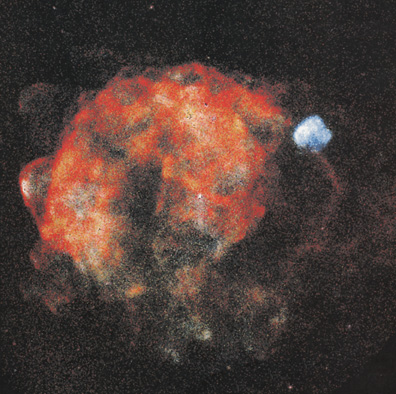CGRO Special Exhibit
Radioactive Decay in Supernova Remnants
The COMPTEL instrument could detect both old and young supernovae – massive star explosions – through measuring the decay of radioactive elements in their fiery ejecta.
Gamma rays from the decay of titanium-44 and aluminum-26, both present in SNRs, were prime targets for COMPTEL, one of Compton's four instruments. 44Ti has a half-life of around 60 years; 26Al has a half-life of 700,000 years. As such, they serve as tracers for both new and old supernovae, respectively.
In 1998, the Compton team came upon one of the closest supernova explosions after detecting titanium-44 near the well-known Vela supernova remnant. The undocumented SNR is 650 light years away and may have been bright enough to be seen on Earth during the daytime in the early 14th century.

ROSAT image of the
Vela Supernova Remnant
Refer to the ROSAT X-ray image (above) of this supernova region. What you are seeing is actually three supernova remnants. The smaller, bright ball in the upper right is the Puppis A SNR; and the large fiery ball in the center is the Vela SNR. Overpowered by the bright Vela emission is the newly identified SNR, hiding in the lower left corner of Vela.
Can't see it? Neither did astronomers.
Now look at a side-by-side comparison of two other ROSAT X-ray images and a COMPTEL gamma-ray image (below). The first two panels show the entire region. The second panel, which shows the region in a slightly different X-ray energy band, begins to reveal the new SNR -- which is actually much closer to Earth than Vela is.

Left: The Vela SNR (filling most of the image) and the smaller Puppis A SNR (near the 2 o'clock position at the edge of Vela) in ROSAT Image at X-ray energies 0.1-2.4 KeV. Center: ROSAT Image for X-ray energies 1.3-2.4 KeV. Right: COMPTEL Image of newly discovered Supernova Remnant
The third panel zooms in on the titanium-44 emission coming from that lower left section of the region, for there were no gamma rays coming from the other parts of the region. Where could the titanium decay be coming from, astronomers asked? Puppis A and Vela are too old; their 44Ti has long since decayed. Because of this, Puppis A and Vela are visible in the ROSAT image but not in the Compton data.
Astronomers realized that there had to be another SNR, much younger, hiding in the region, and turned to the COMPTON data. Sure enough, further ROSAT observations taken independently of the Compton work confirmed the findings. Both the ROSAT and the Compton observations were conducted by MPE in Garching, Germany.
A note about the third panel in figure 2: This image is a likelihood map. The black regions represent the area least likely to produce gamma rays. Then blue, then red, then yellow. The white area represents the most likely position for this gamma-ray source.
The newly discovered supernova is relatively nearby in our Galaxy and should have been easily seen by medieval astronomers, even during daylight hours. Yet there is no written record of the event. The COMPTEL astronomers have a couple of guesses on why this may be. One reason may be simply that the explosion was in the southern sky, so folks far up in the northern hemisphere (i.e., Europe, much of the Islamic world and most of China) couldn't see it since this part of the Milky Way Galaxy never rises above the horizon. Other reasons may be that the supernova was optically obscured by dust and other material in front of it, or that the supernova itself was "optically subluminous," a technical term for being much fainter than the average supernova.
Published: May 2000
Text Reviewed: September 2018


